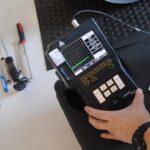Since eddy current inspection makes use of electromagnetic induction, it is important to know about the scientific principles of electricity and magnetism. For a review of these principles, the Science of NDT materials on this Internet site may be helpful. A review of the key parameters will be provided here.
Electricity

It is well known that one of the subatomic particles of an atom is the electron. Atoms can and usually do have a number of electrons circling its nucleus. The electrons carry a negative electrostatic charge and under certain conditions can move from atom to atom. The direction of movement between atoms is random unless a force causes the electrons to move in one direction. This directional movement of electrons due to some imbalance of force is what is known as electricity.
Amperage
The flow of electrons is measured in units called amperes or amps for short. An amp is the amount of electrical current that exists when a number of electrons, having one coulomb of charge, move past a given point in one second. A coulomb is the charge carried by 6.25 x 1018 electrons or 6,250,000,000,000,000,000 electrons.
Electromotive Force

The force that causes the electrons to move in an electrical circuit is called the electromotive force, orEMF. Sometimes it is convenient to think of EMF as electrical pressure. In other words, it is the force that makes electrons move in a certain direction within a conductor. There are many sources of EMF, the most common being batteries and electrical generators.
The Volt
The unit of measure for EMF is the volt. One volt is defined as the electrostatic difference between two points when one joule of energy is used to move one coulomb of charge from one point to the other. A joule is the amount of energy that is being consumed when one watt of power works for one second. This is also known as a watt-second. For our purposes, just accept the fact that one joule of energy is a very, very small amount of energy. For example, a typical 60-watt light bulb consumes about 60 joules of energy each second it is on.
Resistance
Resistance is the opposition of a body or substance to the flow of electrical current through it, resulting in a change of electrical energy into heat, light, or other forms of energy. The amount of resistance depends on the type of material. Materials with low resistance are good conductors of electricity. Materials with high resistance are good insulators.


